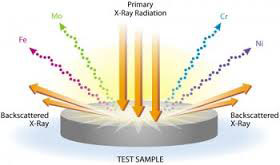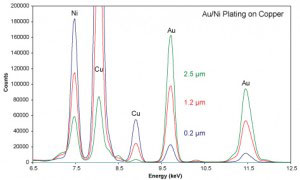0 items in Cart
Assaying
X-Ray Fluorescence Testing – Assaying Metals
 x-ray fluorescense principle
x-ray fluorescense principle
Stackers Gold Bullion offers expert assaying services to customers who want to determine the types and quantities of different metals in an item. We use state-of-the art x-ray fluorescence analysis to determine the metal type (i.e. assaying) and percent of total.
We can identify elements of 26 different metals, including gold, silver, platinum, palladium, copper, zinc, nickel, cadmium, iron, maganese, and lead among many others. Whether you are a silver or gold buyer or seller, want to understand the value of some gold jewelry, or are trying to identify or validate the content of items you have found or had manufactured, Stackers Gold Bullion can provide an accurate assessment of the metal content. We can not assay rocks that you may believe contain precious metals unless there are visible and larger sections containing metal.
If you would like cadmium or lead testing, our x-ray fluorescence testing is the same method/technology that many state agencies use to test toys and other items for lead or cadmium. However, we are not a licensed cadmium or lead tester and cannot provide official documentation.
 x-ray spectrum from x-ray flourescence
x-ray spectrum from x-ray flourescence
Pricing
| 1 to 5 items: | $25 / item |
| 6 to 20 items: | $20 / item |
| More than 20: | call for pricing |
Pricing for XRF analysis does not include the price of shipping should you send us your item and want it returned to you. Call us for details on returning a sample when you are not present for the test.
Written Documentation of Test Results = $60
We can also provide written documentation of the results on all of our testing. This documentation comes written on our letterhead and can, if needed, include a picture of the item tested.
Metal Identification
Base Metals
In mining and economics, base metals refers to industrial non-ferrous metals excluding precious metals. These include copper, lead, nickel and zinc. The U.S. Customs and Border Protection is more inclusive in its definition. It includes, in addition to the four above, iron and steel, aluminum, tin, tungsten, molybdenum, tantalum, cobalt, bismuth, cadmium, titanium, zirconium, antimony, manganese, beryllium, chromium, germanium, vanadium, gallium, hafnium, indium, niobium, rhenium and thallium.
Precious Metals
A precious metal is a rare, naturally occurring metallic chemical element of high economic value. Chemically, the precious metals are less reactive than most elements. They are usually ductile and have a high luster. Historically, precious metals were important as currency but now are regarded mainly as investment and industrial commodities. The best-known precious metals are the coinage metals, gold and silver. While both have industrial uses, they are better known for their uses in art, jewelry, and coinage. Other precious metals include the platinum group metals: ruthenium, rhodium, palladium, osmium, iridium, and platinum, of which platinum is the most widely traded.
Sigma Metalytics Verifiction
Testing your Bullion Bars and Coins
The Sigma Metalytics Verifier is a popular device used to test the authenticity and purity of coins and bars, particularly those made of precious metals such as gold, silver, platinum, and palladium. It utilizes advanced technology to provide accurate and reliable results, giving users confidence in their investments.
The verifier works by employing a process known as electromagnetic wave analysis. It measures the electromagnetic properties of the metal being tested and compares them to the expected values for the specific metal. This analysis is based on the fact that each metal has unique electromagnetic properties that can be measured and verified.
To test a coin or bar, the user places it on the sensor pad of the verifier. The device then sends a series of electromagnetic waves through the metal. The waves interact with the metal and produce a response, which is analyzed by the verifier. The device compares the measured electromagnetic properties with a database of known values for genuine coins and bars. If the measured values match the expected values within a certain tolerance, the item is considered authentic.
The verifier can provide various types of information about the tested item, including its purity, weight, dimensions, and diameter. It can also detect common counterfeiting techniques such as tungsten-filled bars, where a genuine outer layer covers a tungsten core. The device's database is regularly updated to include new coins and bars, ensuring accurate testing for a wide range of products.
One of the notable features of the Sigma Metalytics Verifier is its non-destructive testing method. It does not require any physical or chemical alterations to the coin or bar being tested, preserving its integrity and value. This is particularly important for collectors or investors who want to verify their items without causing any damage.
The verifier is compact and easy to use, making it suitable for both professionals and individual users. Its portable design allows for convenient testing in various settings, such as coin shops, pawnshops, or even personal residences.
In summary, the Sigma Metalytics Verifier is a reliable device that utilizes electromagnetic wave analysis to test the authenticity and purity of coins and bars made of precious metals. Its non-destructive testing method, accuracy, and portability make it a valuable tool for investors, collectors, and anyone interested in verifying the quality of their precious metal items.
